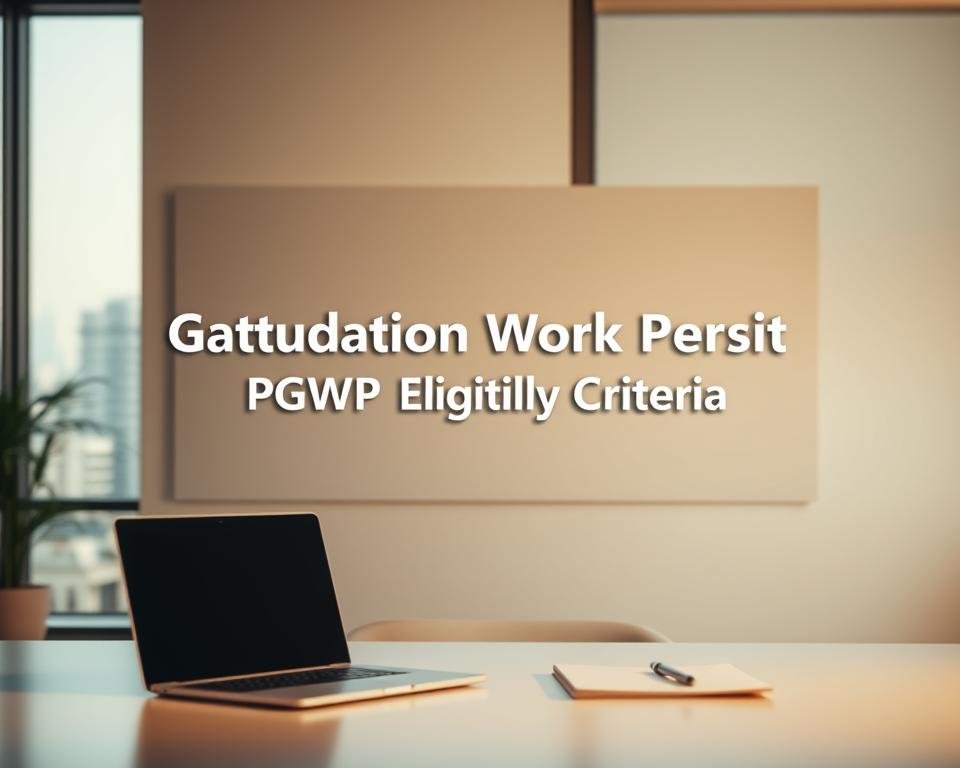Obtain Your Canada Post-Graduation Work Permit

Imagine finishing your studies in Canada and feeling a rush of excitement. You now have the knowledge and skills to start your career. For many international students, this is just the start of their journey.
The Canada Post-Graduation Work Permit (PGWP) offers a chance to gain work experience. It helps you build a strong career in Canada and could lead to permanent residency.
With the PGWP, you can easily move from studying to working. It boosts your credentials and helps you make connections in Canada. Knowing how to apply for the PGWP is key to getting a job.
Whether you want to find new job opportunities or build a long-term future in Canada, this is where it begins.
Before we dive into the application process, let's understand the PGWP. It's a critical step for graduates. For more on studying in Canada and applying for the PGWP, check out this guide.
- Understanding the Canada Post-Graduation Work Permit (PGWP)
- Benefits of the PGWP for International Students
- Canada Post-Graduation Work Permit (PGWP) Eligibility Criteria
- PGWP Application Process Overview
- Documents Needed for PGWP Application
- PGWP Duration and Validity
- PGWP Processing Time
- PGWP Work Eligibility Restrictions
- Common Mistakes in PGWP Applications
- Resources for International Students in Canada
- Next Steps After Receiving Your PGWP
- Insights from Recent PGWP Applicants
Understanding the Canada Post-Graduation Work Permit (PGWP)
The Canada post-graduation work permit is a big chance for international students who have finished their studies in Canada. It lets them work in Canada for a time that can be from eight months to three years. This depends on how long they studied.
This permit is special because you don't need a job offer to apply for it. This is different from other work permits for international students in Canada. It lets students find jobs that match their skills and goals, helping them fit in better in Canada.
Having the PGWP helps graduates grow in their careers. They can make professional connections and learn about the job market in Canada. Working in Canada after studying makes it easier to start a career, helping both the person and the economy.

Benefits of the PGWP for International Students
The Post-Graduation Work Permit (PGWP) is a big help for international students. It lets them get Canadian work experience. This is key for getting ahead in a tough job market.
Having this experience shows they can adapt to Canadian work culture. It makes them more appealing to employers.
Gaining Valuable Canadian Work Experience
Canadian work experience boosts your job chances. With the PGWP, graduates can get skills that employers want. They learn about the local job market.
Doing internships or full-time jobs while on the PGWP is a great way to learn. It connects what you learned in school to real work.
Pathway to Permanent Residence in Canada
The PGWP is also a key step to becoming a permanent resident. It helps through the Canadian Experience Class. This class uses your Canadian work experience to qualify for residency.
Going from a temporary work permit to permanent status is a big step. It makes settling in Canada easier. It helps with the immigration process after studying here.

Canada Post-Graduation Work Permit (PGWP) Eligibility Criteria
International students need to know the PGWP eligibility criteria to work in Canada after studying. To apply for the PGWP, students must be in a qualifying program of study. This program must last at least eight months at a designated learning institution.
Students also need to keep full-time student status during their studies. This is important for Canadian immigration authorities.
Qualifying Program of Study
Choosing the right course is the first step in the PGWP application. The course must be at least eight months long. If it's shorter, students won't qualify for the work permit.
Many institutions in Canada offer these programs. They help students gain skills and prepare for the job market.
Full-Time Student Status
Students must stay full-time in their program to meet the PGWP criteria. This shows they are committed and doing well in their studies. Switching to part-time, even in the final term, can make students ineligible for the PGWP.
Time Limits on Applications
Applying for the PGWP on time is key. Graduates have 180 days after getting their final marks to apply. Missing this deadline can hurt their chances.
Knowing the application timeline is important. It helps students smoothly move into the workforce after graduation.

PGWP Application Process Overview
The PGWP application process has key steps for international students to get their work permit. Knowing these steps helps ensure the application is done right and on time. This increases the chance of getting approved.
Gathering Required Documentation
First, you need to collect all needed documents. The PGWP checklist includes:
- Proof of graduation from a designated learning institution
- Valid passport, including identification pages
- Any previous study permits
- Citizenship documentation if applicable
It's vital to fill out the checklist correctly. Missing documents can slow down your application or cause it to be rejected.
Filling Out the Application Form
After getting your documents, you must fill out the application form online. Use the Immigration, Refugees and Citizenship Canada (IRCC) portal. Make sure all your info is right and complete. Pay special attention to personal and study details.
After filling it out, check your application carefully before sending it. This helps avoid mistakes that could slow down your application.
Documents Needed for PGWP Application
To apply for a Post-Graduation Work Permit (PGWP), you need to gather the right documents. Knowing what you need makes the application easier. Here's a checklist of important documents to help you prepare.
Proof of Graduation
You must show proof of graduating from a Canadian program. You can use your diploma, degree certificate, or official transcripts. These prove you've finished your studies in Canada, making you eligible for the PGWP.
Passport and Visa Documents
Your application needs valid passport copies and any visa documents. These show you're legally in Canada. They're key to proving your identity and following immigration rules.
Application Fee Payment
You must pay an application fee to apply for the PGWP. The fee depends on the permit type. Make sure to check the current fee and include your payment receipt. Without this, your application might be delayed or rejected.
PGWP Duration and Validity
The length of the Post-Graduation Work Permit (PGWP) matches the time spent in your academic program. Knowing how long the PGWP is valid is key for those starting their careers in Canada. It's a chance to get work experience, which helps with future immigration plans.
Length of Work Permit Based on Study Program Length
The PGWP's length changes based on your study program's duration. If your program was less than eight months, you're not eligible for a PGWP. Programs from eight months to two years get a PGWP that matches the program's length. Programs over two years can get a three-year work permit. Here's a table to help you understand:
| Program Length | PGWP Duration |
|---|---|
| Less than 8 months | No PGWP |
| 8 months to 1 year | 1 year |
| 1 year to 2 years | Up to 2 years |
| Greater than 2 years | 3 years |
Renewal and Extension Options
The PGWP is a one-time deal with no renewal options. Once you get it, you can't apply for another one. If you need more time or another work permit, look into other immigration options. These could be different work permits or paths to permanent residency.
PGWP Processing Time
The time it takes to process PGWP applications is key for international students planning their move into Canada's job market. Knowing how long it takes to get approval helps students plan their post-graduation life better. Usually, it takes 80 to 120 days, but different things can change this time.
Timeline for Approval
PGWP applications go through several steps. First, they check if everything is there. If your application is complete, it moves faster. It's important to have all your documents ready when you apply.
Things you can't control, like big backlogs, can also affect how long it takes. It's good to know this to manage your expectations.
Factors Affecting Processing Time
Many things can change how long it takes to process a PGWP. How many applications are in at the same time is a big factor. Learning about these factors helps you understand possible delays. Also, if they ask for more info, it can take longer.
So, making sure your application is right and complete is very important.
PGWP Work Eligibility Restrictions
The Post-Graduation Work Permit (PGWP) is a big chance for international students in Canada. It's key to know the rules about working with a PGWP to make smart choices about jobs during and after school.
While studying, international students face limitations on employment that limit their off-campus work. They can work part-time (up to 20 hours a week) during school terms. But, they can work full-time during breaks. These rules help students focus on their studies and get used to Canada.
Limitations on Employment During Studies
Students need to know the limitations on employment during studies that come with being a student. Working without permission can risk their immigration status and future job chances. Sticking to these rules keeps students eligible for a PGWP after finishing their studies.
Types of Employment Allowed with PGWP
With a PGWP, international students can work full-time in any job they want. This is different from the part-time work allowed during studies. They can find jobs that match their career dreams, helping them gain Canadian work experience and future job prospects.
The PGWP's flexible work rules are a big change for graduates. Knowing the rules during studies and the wide job options after graduation helps graduates smoothly enter the workforce. They can use their school experiences to fit into the Canadian job market.
For more info on work rules while studying in Canada, check out Canada study visa guidelines.
Common Mistakes in PGWP Applications
Applying for a PGWP can be tough for international students. Knowing the common mistakes can help a lot. It's important to understand the eligibility requirements well to avoid errors.
Submitting Incomplete Applications
Many applicants face issues with incomplete applications. Missing documents or not providing enough info can cause delays or even denial. It's key to double-check your documents before sending them off to make sure everything is there.
Misunderstanding Eligibility Requirements
Some people get confused about what makes a program eligible for a PGWP. This can lead to disappointment. It's vital to research and confirm your program meets the criteria before applying.
Resources for International Students in Canada
International students in Canada have many resources to help them adjust and succeed. Schools offer strong support systems to tackle the challenges of a new place. These resources cover academics, career planning, and immigration help.
School Support Services
Schools like universities and colleges have a lot to offer. They provide:
- Career counselling for job searches and interviews.
- Workshops on networking and professional growth for international students.
- Help with immigration rules and procedures.
- Mental health resources and peer support groups.
Online Immigration Guides
Online guides are key for understanding the PGWP application process. They offer:
- Step-by-step guides for application forms.
- Info on deadlines for the PGWP.
- Advice on gathering documents and proving eligibility.
Using these resources, international students can prepare well for life in Canada. This ensures a smoother transition from school to work.
Next Steps After Receiving Your PGWP
After getting a Post-Graduation Work Permit (PGWP), graduates should plan their next steps. This is a great chance to turn their studies into real work experience in Canada. It's an exciting time for international students to start their professional journey.
Exploring Job Opportunities in Canada
Start by looking for jobs in Canada. Use online job sites like LinkedIn, indeed, and Job Bank. They have lots of jobs for newcomers. Networking is also key to finding a job. Join local groups, connect with alumni, and go to job fairs to boost your chances.
Here are some tips for finding jobs:
- Use online job sites and job boards.
- Meet industry experts at networking events.
- Go to job fairs and recruitment events.
- Try internships or volunteer work to get experience.
Understanding Your Rights as a Worker
It's also important to know your rights as a worker. Learn about Canadian labour laws. They cover things like wages, working conditions, and fair treatment. Key rights include:
- The right to a safe work environment.
- The right to get paid on time and fairly.
- The right to report workplace issues.
- The right to fair treatment, no matter your background.
Knowing your rights helps you deal with the Canadian job market better. It ensures you're treated fairly and with respect.
Insights from Recent PGWP Applicants
Recent PGWP applicants share a variety of experiences. They talk about both the tough times and the victories. Many highlight the need for good preparation and knowing what you qualify for.
They also mention how important it is to work closely with your school. Using all the resources available can make things easier.
Applicants often face problems like missing deadlines and not understanding what documents are needed. These issues are important lessons for those planning to apply. They show how important it is to meet deadlines and have all your documents in order.
Getting test results, like the CELPIP, is also key. It checks your language skills and is a big part of the application.
Graduates' stories help future applicants by showing them how to deal with the PGWP system's challenges. By using detailed immigration guides and learning from others, you can improve your chances of getting a PGWP.
These stories also show how important it is to have support from your community. Sharing knowledge and experiences can help you on your path to getting a PGWP.
If you want to know other articles similar to Obtain Your Canada Post-Graduation Work Permit You can visit the category Migration.

Leave a Reply